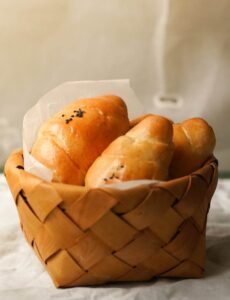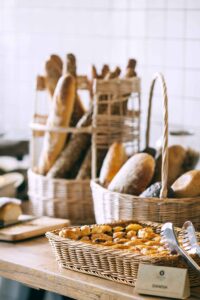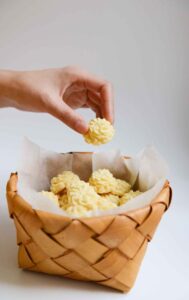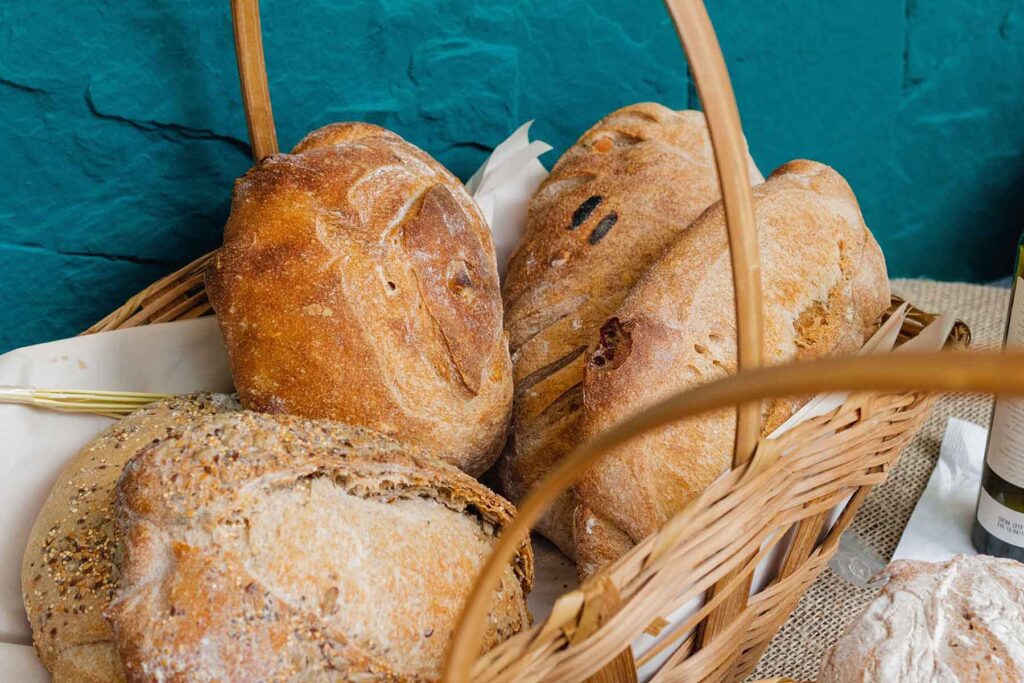A banneton basket is around, wicker-like container used for shaping and proofing bread dough before baking. The basket is lined with a linen or cotton cloth which absorbs any excess oil from the dough during the rising process to help create an even crust on the finished loaf.
A banneton can also be used as an alternative to kneading by hand or using other mechanical means of developing the gluten in yeast doughs.
What Does A Banneton Basket Do For Bread Dough?
A banneton bread basket is an essential tool for creating the perfect loaf for most bakers and bread lovers.
A round, wicker-like container lined with linen or cotton cloth is used to shape and proof bread dough before baking. The basket’s natural properties promote even crust on finished loaves because of its absorbent qualities. A banneton can also be used as an alternative to hand kneading by manually developing the gluten in yeast doughs before rising and shaping into loaves.
The use of the word ‘banneton’ dates back centuries ago when baskets were woven from willow twigs known as ‘banners’. Nowadays, these baskets are made of cane fiber and usually have rounded bottoms that allow them to stand upright without flattening out like some other standard bread baskets.
Many bakers also use bannetons to create a more professional-looking finished loaf with minimal effort. They allow for better airflow during the process of bread dough rising. In addition, the basket’s shape, texture, and size contribute to creating an even crust on loaves when baked in the oven.
A banneton can also be used as an alternative to kneading by hand or using other mechanical means of developing the gluten in yeast doughs. If you are not convinced that one should invest in this indispensable tool, take a look at some advantages:
It makes it easier when transferring your dough onto parchment paper because there’s no need to use flour;
You have better control over how much air enters into your loaf via sloppy hands ; You can shape your dough with a banneton because it’s very malleable; and, The cloth lining absorbs any excess oil from the dough to create an even crust on the finished loaf.
How To Use A Banneton Basket
 If it’s your first time using a banneton basket, follow these easy steps to get the process started.
If it’s your first time using a banneton basket, follow these easy steps to get the process started.
Pour a small amount of flour onto your work surface and rub it in well before placing dough on top;
Cover with linen or cotton cloth (the type you use will depend on whether you need a coarse, medium, or fine texture);
Flatten out any wrinkles that form by patting down gently with banneton’s bottom edge; and, finally,
Allow bread dough to proof for at least 60 minutes and up to 90 minutes if desired. You’ll know when your dough is finished rising because it will become soft all over.
Tip: To maintain its shape while being baked into an evenly browned loaf, remove from the basket after proofing and pop it into a preheated oven.
Things to Consider: Bread can be shaped with the banneton before rising for about 60 minutes or up to 90 minutes if desired (you’ll know when your dough is finished rising because it will become soft all over). Then remove it from the basket after proofing and pop it in a preheated oven.
Loaves created using this process have an evenly browned loaf but slightly less crisp crust than bread made without waiting for the dough to rise at room temperature first. Use flour on the work surface as needed; cover the cloth lining of the banneton with a baking sheet or parchment paper before adding dough to prevent sticking.
How To Care For Your Banneton Basket After Use
Banneton basket is a valuable tool for bread dough rising. A banneton, which comes from the French “bain,” or bathtub, is an oval-shaped wicker container with many slits on its surface that allow excess moisture to be released and facilitates air circulation around the loaf as well.
The shape of this instrument naturally forms a concave on one side where the dough can rise evenly without being disturbed by an edge.
It’s essential to take care of your banneton after use because if not cleaned properly, it will begin molding within days and retain bacteria indefinitely even when dry. It also has the potential to harbor odor-causing microbes such as Staphylococcus Aureus (aka MRSA).
The following are steps for care of a handmade banneton:
 Soak the basket in cold water to rinse off any excess dough or bread.
Soak the basket in cold water to rinse off any excess dough or bread.
Let it soak until you can properly wash it with soap and warm water, then scrub vigorously so that all yeast cells and stains are removed from the wicker surface. Rinse well! You may use a diluted bleach solution if desired but make sure to let air dry completely after washing before storing away.
Dry thoroughly is also beneficial because organisms will be less likely to survive without moisture present.
Store in an elevated area where there isn’t much contact with other surfaces which might collect dirt or dust over time – this includes closets, garages, basements, etc.
Store in an accessible place from direct sunlight where it will not be exposed to extreme temperatures. This includes attics, garages, basements, or any other area with high heat and humidity levels, such as the outdoors during summer months near an air conditioning vent during winter.
Sunlight can weaken wicker over time by breaking down cellulose fibers, which gives structure to plants like bamboo and rattan palms. This makes them more fragile and susceptible to splitting when handled, while moistening may lead to the rapid decay of wooden materials within days if left unchecked.
Now your banneton looks brand new again after taking care of it properly following these steps. You’re ready for another loaf of dough rising now.
Tips for using the banneton with different types of pieces of bread
Sourdough bread: to speed up the souring process, put a cloth or tea towel over your banneton. If you like very sour bread, leave it under for 24 hours and then remove it when you shape the dough into its final form (so if you’re baking in a dutch oven with a lid, uncover after shaping).
For less acidic loaves of bread using yeast as leavener, cover only halfway through the rising time because these loaves will have air bubbles, and they need room to expand! You can also use rice flour as an extender, in this case, so your dough doesn’t stick too much.
Common Mistakes To Avoid When Using A Banneton Basket

Don’t forget the flour. If you don’t add enough flour, your dough will stick to the wicker basket and make it hard for air to circulate freely around it.
If you’re using a metal banneton, use plenty of oil or nonstick spray so that when you shape your dough into its final form, nothing sticks.
This is particularly important if you are trying out a recipe with less sugar than usual because, without all those added sugars, there’s no outer protective coating on your loaf. You want everything as easy to handle as possible before putting it in the oven.
Traditional White Bread: not all white bread recipes require sugar – some even use honey or maple syrup. If you are using a banneton and don’t want to add any extra sugar, make sure the dough is still moist enough so that it doesn’t stick to the wicker basket but not too wet because if there’s too much liquid in your loaf, then steam can escape from the bread during baking.
Multigrain Bread: this recipe uses very little flour as an extender (usually only whole wheat flour) and has many seeds mixed into it, which will tend to clump together more than other types of bread do. To avoid having these dense spots throughout your finished product, after shaping, just put them on top of each other while they’re still in their bowl before moving onto proofing.
Quick Bread: this may be the easiest bread to make in a banneton because they’re quick and don’t need long periods of rising time, so you can cover your bowl as soon as it’s shaped
Just remember that these types of bread are more like cakes or muffins than traditional yeast dough loaves, so there’s no gluten development to speak of and very little sugar added – if any at all. In addition, the texture is moist due to eggs, which tend not to dry out during baking.
Final Words
Banneton baskets are just an extra tool for making bread dough rise more efficiently. If you’re not sure about them, don’t feel like you have to invest in one – experiment with your loaves by using a cloth or towel instead and see if it makes any difference. However, having one around can come in handy if you want to experiment with a new recipe that requires more time for rising, so you don’t need to worry about your dough getting too dry.


